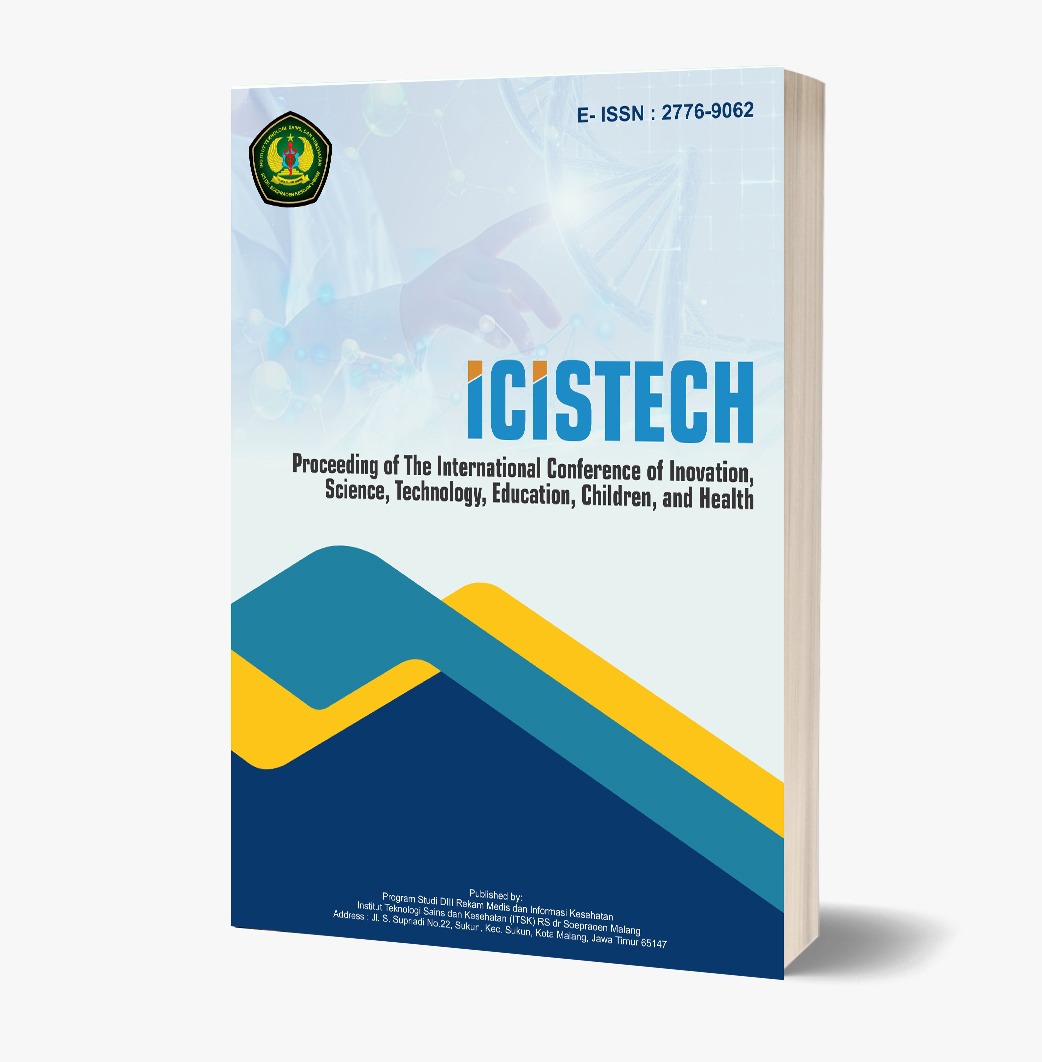The Effect of Giving Additional Food to Pregnant Women with Chronic Energy Deficiency at Ribang Community Health Center
DOI:
https://doi.org/10.62951/icistech.v5i1.260Keywords:
CED, Pregnant Women, Supplementary NutritionAbstract
Chronic Energy Deficiency (CHD) is a condition resulting from an imbalance in the intake of energy and protein nutrients needed by pregnant women. The impact of CHD during pregnancy can lead to severe complications, including an increased risk of maternal and infant mortality. To address this, the Supplementary Feeding Program (PMT) is often implemented to improve the nutritional intake of pregnant women. The aim of this study was to determine the effect of PMT on pregnant women with SEZ (Chronic Energy Deficiency) at the Ribang Health Center. The sample consisted of 15 respondents. Data collection involved measuring the upper arm circumference (LILA) of pregnant women using a LILA tape and an observation sheet to track PMT participation. The research employed a non-equivalent quasi-experimental design, utilizing a quantitative approach with a one-group pretest-posttest design. Data analysis was conducted using the Wilcoxon statistical test to assess changes in the participants' LILA before and after the intervention. The results showed a notable improvement in the size of the upper arm circumference (LILA) in the respondents after receiving the PMT intervention. Before the intervention, 100% of the respondents had a LILA measurement of less than 23.5 cm, indicating chronic energy deficiency. After the intervention, 40% of respondents still had a LILA measurement of less than 23.5 cm, but 60% of the respondents showed a significant improvement with a LILA greater than 23.5 cm. The statistical analysis revealed a significant difference in LILA measurements before and after the intervention, with a p-value of 0.000. In conclusion, the provision of PMT has a significant positive effect on improving the nutritional status of pregnant women with chronic energy deficiency, as evidenced by the increase in their LILA measurements
References
Agustina, W., & Sri, S. (2018). Management of pregnant women with hyperemesis gravidarum at Wonogiri Hospital. Jurnal Ilmiah, Universitas Bhakti Mulia Sukoharjo.
Direktorat Jenderal Kesehatan Masyarakat Kementerian Kesehatan. (2021). Laporan Kuntabilitas Kinerja Instansi Pemerintah (LAKIP) Ditjen Kesehatan Masyarakat Tahun 2021 (pp. 1-68). Kementerian Kesehatan Republik Indonesia. [Link to PDF: ploald/dir_60248a365b4ce1e/files/ Laporan-Kinerja-Ditjen-KesmasTahun- 2017_edit-29-jan-18_1025.pdf]
Farahdiba, I. (2021). The relationship of chronic energy deficiency (CED) with the incidence of anemia in primigravida pregnant women at Jongaya Public Health Center Makassar in 2021. Jurnal Kesehatan Delima Pelamonia, 5(1), 24-29. https://doi.org/10.37337/jkdp.v5i1.213
Fathony, Z., & Nuriaty, R. S. (2021). Pregnant women at Pekaluman Public Health Center Banjarmasin: Overview of chronic energy deficiency in pregnant women. Journal of Midwifery and Reproduction, 5(1), 54-57.
Fitri, S. R., Lestari, B. C., Indriana, N. P. R. K., Meiranny, A., Hasyim, D. I., Saputri, N., & Prisusanti, R. D. (2024). Asuhan kebidanan neonatus: Bayi balita dan anak prasekolah berbasis evidence-based practice. PT. Sonpedia Publishing Indonesia.
Florida, R., Ekasari, T., & Zakiyah, M. (2023). The relationship between nutritional status and the incidence of anemia in pregnant women at Labruk Public Health Center Sumbersuko District Lumajang Regency. Jurnal Nursing Update, 14(3), 407-413. https://stikes-nhm.e-journal.id/NU/index
Frijanto, A. (2022). Direktorat Jenderal Pelayanan Kesehatan. In Kementerian Kesehatan RI. https://yankes.kemkes.go.id/view_artikel/1222/gula-si-manis-yang-menyebabkan-ketergantungan
Ghazali, P. L., & Maulida, F. (2019). Breastfeeding behavior in mothers with HIV-AIDS in Yogyakarta City. Media Kesehatan Masyarakat Indonesia, 15(4), 376. https://doi.org/10.30597/mkmi.v15i4.7931
Iskandar, I., Rachmawati, R., Ichsan, I., & Khazanah, W. (2022). Nutritional improvement in pregnant women with chronic energy deficiency (CED) through mentoring for supplementary food provision in the Lambisang Public Health Center working area, Aceh Besar. Jurnal PADE: Pengabdian & Edukasi, 4(1), 34. https://doi.org/10.30867/pade.v4i1.900
Kemenkes RI. (2021). Buku saku merencanakan kehamilan sehat.
Kemenkes RI. (2022). Petunjuk teknis pemberian makanan tambahan (PMT) berbahan pangan lokal untuk balita dan ibu hamil (pp. 78-81). Kemenkes. https://kesmas.kemkes.go.id/assets/uploads/contents/others/20230516_Juknis_Tatalaksana_Gizi_V18.pdf
Medika, R. K. (2019). Gizi seimbang bagi ibu hamil. In RS Krakatau Medika. https://krakataumedika.com/info-media/artikel/gizi-seimbang-bagi-ibu-hamil
Nurherliyany, M., Ariani, D., Asmarani, S. U., Anggit Herdiani, D., & Maharani, A. P. (2023). The importance of laboratory examinations in pregnant women. Daarul Ilmi: Jurnal Pengabdian Kepada Masyarakat, 1(1), 1-7. https://doi.org/10.52221/dalipkm.v1i1.233
Pastuty, R., & Herawati, T. (2018). Effectiveness of the recovery program of food supplement towards pregnancy women with chronic energy deficiency in Palembang city introduction. 9(November), 179-188. https://doi.org/10.26553/jikm.v9i3.310
Pertiwi, H. W., Martini, T., Handayani, M., Program, S1, S., Stikes, K., & Utomo, E. (2020). Chronic energy (CED). Jurnal Kebidanan, XII(01), 1-128.
Prisusanti, R. D. (2021). Metodologi penelitian di berbagai bidang.
Prisusanti, R. D., Dewi, C., Kiriwenno, E., Prastiwi, R. S., & Epid, M. (2022). Kesehatan reproduksi dan kesehatan wanita. Yayasan Penerbit Muhammad Zaini.
Puspitasari, M., Mitra, M., Gustina, T., Rany, N., & Zulfayeni, Z. (2021). Supplementary food provision for CED pregnant women at Karya Wanita Public Health Center Pekanbaru. Jurnal Kesehatan Manarang, 7(2), 141. https://doi.org/10.33490/jkm.v7i2.325
R, N. U., Mustamin, M., & Ipal, A. (2019). Family income with less chronic energy (LCE) in pregnant women. Media Gizi Pangan, 25(2), 57. https://doi.org/10.32382/mgp.v25i2.391
Rahmadhanti, I., et al. (2023). Asuhan kebidanan kehamilan. In Paper Knowledge Toward a Media History of Documents (Vol. 135, Issue 4).
Sastri, N. (2023). Risk of chronic energy deficiency (CED) in pregnant women at Siring Alam village posyandu, Ogan Ilir. Khidmah, 5(2), 155-162. https://doi.org/10.52523/khidmah.v5i2.454
Silfia, N. N., Malinai, A., & Yustika, Y. (2022). Factors for chronic energy deficiency (CED) in pregnant women. Napande: Jurnal Bidan, 1(1), 40-48. https://doi.org/10.33860/njb.v1i1.1047
Utami, R., Gunawan, I. M. A., & Aritonang, I. (2018). The effect of recovery supplementary food provision (PMT) on nutritional status in pregnant women in Sleman Regency. Jurnal Nutrisia, 20(1), 19-26. https://doi.org/10.29238/jnutri.v20i1.115
Downloads
Published
How to Cite
Issue
Section
License
Copyright (c) 2025 Proceeding of The International Conference of Inovation, Science, Technology, Education, Children, and Health

This work is licensed under a Creative Commons Attribution-ShareAlike 4.0 International License.













